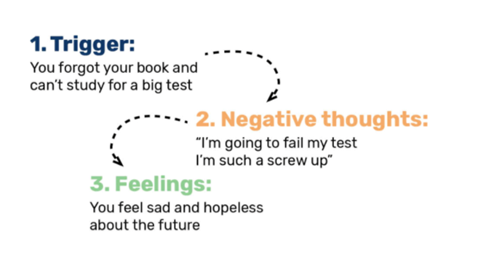Anxious feelings

Everyone has fears and worries. That’s OK - they’re part of a normal human experience. You go through lots of changes as you grow, so it makes sense for you to feel this way sometimes.
If these worries begin to affect how you feel on a regular basis, you may need extra support. But there are some simple steps you can take to help. Here are tips to recognise anxious emotions, and how you can manage them.
What causes anxious feelings?
You may feel anxious when there’s a big change or stressful event in your life. Examples of this could be starting school, moving home, or exams.
There won’t always be a big event that triggers anxious feelings - how we feel is partly what happens and partly how we interpret situations. You can use the ‘1 + 2 = 3’ method to help you understand you emotions. It looks like this:

The image helps to illustrate the link between an event (the ‘trigger’), our thoughts, and our feelings.
If you try replacing a negative thought with a more positive one, your feelings about the trigger will change.
How do I know if I have anxious feelings?
If you have some anxious feelings, signs might include:
- Restlessness
- Irritability
- Struggle with sleeping
- Muscle tension
- Inability to control fear or worry
- Poor concentration
- Fatigue
Sometimes when you’re worried or fearful, you will behave in a way that’s stressful for parents or caregivers. It may seem like ‘attention-seeking’, but it’s important to remember that you may be going through a difficult time and are in fact ‘care-seeking’.
How can I manage my anxious feelings?
Make time to talk
Teenagers don’t always want to talk, and it’s important that others respect your space. It doesn’t mean there’s a problem. The best thing to do is to let people know when you need to talk.
Try to get into the habit of having chats with a parent, a carer or a trusted adult about how things are going in general. Talk about how you’re feeling and say what you want to say. The more you talk and listen, the sooner you may get the help you need when you have a problem.
Activity: a moment of calm (the palm pebble)
>> Useful if you are feeling anxious.
This activity can help you refocus their mind and feel calmer. Try the following:
- Find a small object that you can fit in your hand. This could be any anything with an interesting texture (such as a pebble). Explore it with your hands, feeling the bumps, grooves and rough areas.
- Describe what you’re feeling, which bit you like or dislike.
- The process helps to refocus the mind, slow breathing and reduce the stress hormone, cortisol. If find the activity useful, you can use it as your ‘go to’ resource in times of worry.
Activity: how thoughts influence actions
>> Useful for building understanding of how we experience anxious feelings and how we react.
The below helps explain how thoughts and feelings are connected to actions.
Here’s an example of how the three are connected:
1) Thoughts influence feelings
After studying hard but doing poorly on a test, you might think, “I’ll never succeed at anything.” This makes you feel bad about your abilities as a student or worry about the future.
2) Feelings influence actions
You feel anxious about studying for the next exam, and dwell on your feelings. You then put off studying because you still feel discouraged about the last exam.
3) Actions influence thoughts
Your lack of studying for the next exam results in another poor grade. You think, “I don’t know why I even keep trying. It’s useless. I’m a failure.”
Download the exercise. Take some time to read through and reflect on how this links to your own experiences. Then use it to talk with your parent, carer or a trusted adult about how negative thoughts can influence how we behave:
- Speak to an adult you trust about how thoughts, feelings and actions are connected.
- Remind yourself how a recent event affected your thoughts.
- Think about how you acted as a result. What if you were to think differently about what happened?
Activity: ask questions to challenge anxious thoughts
>> Useful if you already have some understanding of the connection between thoughts, feelings and actions.
Anxious thoughts can feel overwhelming. But remembering that they’re not always rooted in reality can take away some of their strength. Work through these questions, on your own or with an adult you trust:
- What do I have to tell me that my anxious thoughts are true or not true?
- How many times have I felt this way before? What was the outcome afterwards?
- What’s the worst that could happen in this situation? If that did happen, how might I handle it? Would I still be OK?
- How much of my judgement is based on facts vs feelings?
Ask yourself these questions whenever you feel anxious or worried. It can help you see that feelings are not always an accurate reflection of what’s happening.
